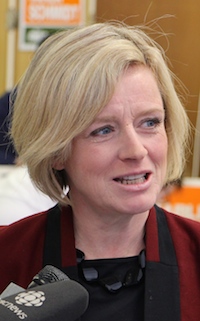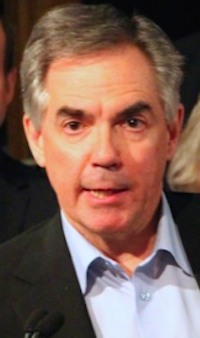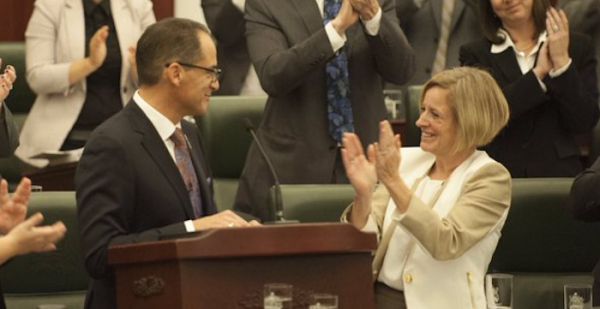When Finance Minister Joe Ceci stood in the Legislature on Oct. 27 to deliver the Alberta NDP’s first budget, it marked the first time since 1972 that the budget was not tabled by a Progressive Conservative finance minister.

The first budget of Premier Rachel Notley‘s NDP government includes a 15 percent increase in capital spending over the next five years, with a goal to create jobs and tackle the province’s aging and neglected hospitals, schools, roads and other public infrastructure.
The NDP budget includes modest increases and projected stable funding for health care, education, advanced education and human services – core services that Albertans depend on. This was a key component of the election platform that helped propel the NDP into government on May 5. The job creation and economic stimulus elements of the budget followed last week’s creation of an Economic Development and Trade portfolio, led by Edmonton MLA Deron Bilous.

A projected $6.1 billion deficit in the NDP budget is larger than the $5 billion deficit presented in the Tory spring budget, which was tabled but never passed. But the Alberta government’s eighth consecutive deficit budget is “…hardly sky is falling territory,” wrote University of Calgary economist Trevor Tombe in Maclean’s Magazine this week.
“While not trivial, obviously, it is completely manageable. Alberta is fully able to handle it and no one need panic. It represents 1.8 per cent of the province’s GDP, which is fairly small, as far as some deficits go,” Dr. Tombe wrote.
The NDP government will borrow to pay for parts of its operations budget starting next year, which will hopefully be a short-term move. Decades of bad financial management and poor long-term planning by the previous conservative government has exacerbated the provincial government’s current fiscal situation. The PCs simply became too comfortable and dependent on unreliable revenue from natural resource royalties to fund the province’s operations budget.

Mr. Ceci also announced that the government would legislate a debt ceiling of 15 percent debt-to-GDP in order to hold off a risk of credit downgrades and higher debt service costs.
Former premier Jim Prentice was correct last year when he warned about getting “off the royalty roller coaster.” The Alberta government faces serious revenue problems and moving Alberta away from its over dependence on resource revenue will be a significant test of Ms. Notley’s first term in government.
Any plan to deal with the revenue problem will likely come after the government receives a much anticipated report from the royalty review panel chaired by ATB President and CEO Dave Mowat. The panel is expected to finalize its recommendations by the end of the year. But it will not be enough to simply wait for the international price of oil to rise again. Albertans need to have a serious conversation about revenue and taxation, including the potential introduction of a provincial sales tax.

To no ones surprise, Wildrose Party leader Brian Jean and finance critic Derek Fildebrandt responded to the NDP budget with outrage and a message filled with apocalyptic rhetoric.
Mr. Jean’s post-budget press conference was somewhat overshadowed by Mr. Fildebrandt’s bizarre decision to refuse to answer a question from Globe & Mail reporter Carrie Tait (see the ~8:50 mark in this video). Mr. Fildebrandt is sour from a recent interview Ms. Tait published in which she quotes him as claiming the NDP duped Alberta voters by actually implementing promises made during the election (and he later referred to Ms. Tait as a b-list reporter and accused her of auditioning for a job in the Premier’s Office – a comment he later retracted).

A joint opinion-editorial written by Wildrose MLAs Rick Strankman (Drumheller-Stettler), Grant Hunter (Cardston-Taber-Warner), and Don MacIntyre (Innisfail-Sylvan Lake) and Dave Schneider (Little Bow) and circulated to rural weekly newspapers in September 2015 provides some sense of how that party would approach provincial budgeting if elected to government:
“When governments borrow and spend, there’s no marketable asset. There’s only debt. It’s like using a credit card to buy pizza. Even when governments borrow to spend on bridges and highways rather than programs, the debt is still not connected to a marketable asset. It’s a liability. Mortgages can be liquidated. Houses can be sold. Who buys used government bridges and worn-out highways?”
This is a crude ideological approach to public governance. Using capital financing to pay for the construction and maintenance of public infrastructure like hospitals, schools, bridges and roads is nothing like using a credit card to buy a pizza.
The Alberta NDP’s first provincial budget is sensible and reflects the thoughtful approach that has defined the first six months of Ms. Notley’s tenure as Alberta’s Premier. Rather than follow a disastrous road taken by some of her predecessors, and slash funding to government services while the price of oil is low, the NDP government is taking an opportunity to invest in much needed public infrastructure when the economy is slow and the price is right. It’s not a brand new approach in Alberta politics, but it is refreshing to see a government focus on building rather than tearing down.


17 replies on “Sky does not fall as Alberta NDP presents its first budget”
Hey Wildrose, it’s 1950 and there’s a casting call for Leave it to Beaver. They love your kooky ideas.
Surprising to everyone last years budget was balanced. It wasn’t predicted to be balanced in any quarter, but it was!
WRP debt derangement syndrome… vs. balanced econ view
http://edmontonjournal.com/news/politics/good-debt-bad-debt-whats-the-difference-for-albertans
excerpt: Q: Is there good debt for a jurisdiction like Alberta at this point in time?
Milligan: “In terms of infrastructure and a long-term investment, there is a case to be made for that. I recall something Mayor (Naheed) Nenshi said, that the cost of renting construction equipment is lower now than a year ago because there is less demand. The point being that when resources are freed up, it’s not a bad time to make investments.
The sky isn’t falling but with record debt and tax increases, our wallets are and our children will pay.
Look up With Friends Hummel on Google to learn about money and government. He is an American. He has a good explanation of money and finance. A real eyeopener for all of us.
Also Ellen Brown. But you could go Canadian and look at COMER the group suing the Bank of Canada and the government.
There are two aspects of the budget which are concerning. The first is that they’re borrowing for operations. The second is the potential downgrading of the credit rating. Alberta can easily handle debt at this stage but the question is what kind of debt (capital versus operational) and whether or not rating agencies remain confident that the government can manage its finances properly.
So maybe Alberta should look at public banking solutions. Screw the bond rating agencies. Use your own bank if you have one and if you don’t create one and borrow from it. See Ellen Brown’s The Public Banking Solution. Start thinking outside the economic box that the banksters want you confined to.
Not really. You will pay. See my articles The Myth of the Balanced Budget. Your children will benefit. They will have services available to them. But that is another debate.
When we elected the NDP and turfed the Conservatives it was because we saw the economic tough times coming and knew that the Conservative (and Wildrose) dismal economic management strategies of the past decades would only make things worse. We voted against the debilitating austerity and wait for the next boom budgeting. Thankfully, the Notley government has remained true to it’s campaign promises and is giving us the kind of economic management that we wanted, expected, demanded and voted for. Thankfully, the engines of real prosperity in the province are being invested in. My only regret is that this budget did not introduce a provincial sales tax. Alberta is in a serious structural deficit from the decades of lack of provincial taxes. It’s time we got over our short-sighted hubris and antipathy for a provincial sales tax.
the NDP delivered a well thought out budget. It focuses on diversifying the economy and when combined with Liberal promises to put money into infrastructure will benefit Alberta in the long run. With respect to FIldebrandt’s behaviour toward the media, one might think that he is auditioning to replace Harper
As usual, the writers and the NDP miss the real issue of the deficit. It adds to the debt which by itself is not an issue. What is the issue is that it has an interest charge to it. That interest paid out of tax dollars goes to the money-lenders — for the most part those who are well-off. Even balanced budgets transfer enormous amounts of tax dollars to the well-off. I have written about the Myth of the Balanced Budget which has been published in various forms in different publications. That myth includes the notion that it is such a small part of the GDP there is noting to be worried about. Federally the Harper balanced budget transfers $25.7 billion of our tax money to the well-off. That is the third highest expenditure after seniors and health care and more than defense. My argument is not to worry about the debt but worry about to whom we owe it. If you want to read my most detailed version of this problem go to . In the forthcoming issue of ER from COMER there is a follow-up to the Myth article. I am not from Alberta and do not know about your banking institutions but if there is not a publicly owned financial institution, one should be established similar to the one in North Dakota. When the government owns its own bank the interest paid on the loans is returned to the government. It is how we paid for the WWII, the St.Lawrence Seaway, airports, schools, nat’l highways and hospitals, univeristies during a time of unprecedented growth and prosperity in the 50s and 60s. If you check the CBC site (google Canada’s Deficits and Surpluses 1963 to 2015) you will find that something changed in the mid 70s to cause these debt problems!
Why is the submission changed? It has removed the link to other articles.
What are the budget deficit projections for the next few years? Its the trend I am worrying about. I am not blaming the NDP for the mess. But I am worried, we will go the way of Romanow or Rae?
The sky isn’t falling. But our net worth is, and our credit rating, and or formerly great province ruled by conservatives, the secret to our success.
When I need to borrow money, I borrow money from my family savings account. Albertans have a provincial savings account called the Heritage Trust Fund.
I wonder why we don’t use our own money from the Heritage Trust Fund instead of borrowing and paying interest to others?
We could be paying interest to ourselves instead of others.
What is the current return on the money in the Heritage Trust Fund?
It is pretty low. This poor rate of return makes me wonder at the investment staff employed by the government of Alberta; surely they can ensure that the fund produces more than a 0.2% return?
http://www.finance.alberta.ca/business/ahstf/
Modest growth for Heritage Fund in first quarter despite market uncertainty
August 31, 2015
Growing market uncertainty, caused in part by developments in Greece and economic stagnation in China, contributed to near-zero growth for the Heritage Fund during the first quarter of the 2015-16 fiscal year. Although the Fund returned only 0.2 %, realizing past gains helped the Fund produce a solid net income of $453 million.
***********************
A return of 0.2% on the Heritage Trust Fund monies seems abysmally poor.
And what is the interest rate that we pay for money we borrow?
It seems we don’t pay very much for borrowing costs according to this blurb below but I am pretty sure it is more than 0.2%.
http://alberta.ca/budget/budget-process.cfm
Low interest rates and Alberta’s excellent credit rating means government can borrow money at a reasonable rate of interest. That means it’s easier to pay this debt back.
*************
So my question is why do we have to borrow from banks and pay what the Wildrose party estimates to be a major sum of cash in interest charges over time?
Why don’t we use our own Heritage Trust Fund Bank and pay ourselves the interest charges?
The Wildrose party indicates we will be paying:
$1.3 billion in debt-servicing costs by 2017.
****************************
Now $1.3 billion seems like a nice return for money borrowed from the Heritage Trust Fund Bank. In any case it isn’t any worse than a 0.2 % return. An additional benefit to using our own money for loans is that we would not need to pay for a staff of investment folks since there would be no investments. We would be providing loans to ourselves. The interest from these loans would go back to add to the fund as a interest income instead of investment income. It would sort of be like getting money like a GIC than a mutual fund.
What happens to the investment income that is generated by the Heritage Fund?
http://www.finance.alberta.ca/business/ahstf/faqs.html
The investment income earned by the Heritage Fund, less the amount retained in the fund for inflation proofing, is transferred to the province’s main operating fund, the General Revenue Fund, to help pay for priority programs.
***************
Money generated from investments is now used to fund other programs.
With a current return of 0.2% we aren’t getting much money for use for these other programs. Investment profits minus the amount used to “inflation proof” the fund –provides the cash that is used for “priority projects”:
If we borrowed from the Heritage Trust Fund for infrastructure projects, paid the interest to ourselves and then used the interest payments— for these priority projects I’m guessing this would save us a pile of interest charges in this borrowing cycle.
While I don’t think that it is bad to borrow for infrastructure needs from the Heritage Trust Fund or banks, I don’t agree with the idea of borrowing for ongoing expenses. Why would we do this ? It is like having our running expenses on a credit card that is paid off somewhere way in the future for big bucks. Short term use of this strategy might be fine but government never does anything efficiently so I doubt that this sort of use of a credit card for operating expenses will be a short term strategy.
Everyone says there is no choice but live on credit in this way. Actually this is not true. We do have some choices. We can decrease our expenditures. Staff constitutes a major chunk of our expenditures.
We could cut the public service and the associated ABCs (agencies, boards and commissions). Why didn’t we cut staff in this budget? I guess this isn’t a popular idea but I don’t see the deliverables for many of the high end and executive staff we employ. These high end and executive folks should be let go and we should run government with a pruned down administrative staff as well.
Front end staff in contrast do provide value for the money spent; not all of them but we do have some good front end staff and they should be retained.
I’m guessing that front end staff like my sons’ doctors and nurses are far more productive than managerial and executive staff who spend all their time in meetings doing very little except generate more policy and procedure documents, more patient safety frameworks without actual safety observed; and such staff should be let go in my humble opinion. There are too many people doing too little in upper management. There are too many ABCs without deliverables. I think there is a lack of productivity among higher end staff that is deplorable and generating paper doesn’t equal deliverables in my mind. Busy work is not deliverables.
Dave Cournoyer is an unapologetic communist!